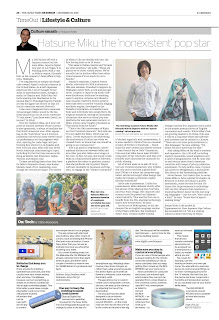Hatsune Miku to tour North America in 2016, for The Japan Times
By ROLAND KELTS
My 2015 kicked off with a January concert by Hatsune Miku, Japan’s digital pop star, in Las Vegas. It is wound down with a visit to Miku’s creator, Hiroyuki Itoh, at his company’s head office in Sapporo, Hokkaido.
I’ve long learned to temper my skepticism toward Japan’s cultural presence in the United States. As a half-Japanese American kid, I never thought I’d see sushi in supermarket aisles, manga in malls, or Pikachu and Hello Kitty balloons soaring over Manhattan in the annual Macy’s Thanksgiving Day Parade, as they did again last year in that distinctly American matsuri (festival).
I also never imagined that a Japanese virtual singer (Miku) would be the featured musical act on an iconic American TV talk show (“Late Show with David Letterman” in 2014).
Now the resilient Miku, an 8-year-old piece of musical software whose content is user-generated, is about to headline her first North American tour.
After appearing on the “Late Show” as a 3-D screen projection (the second most-viewed musical performance on the program’s web site), opening for Lady Gaga, and performing four shows in Los Angeles and New York last year, Miku will tour seven North American cities starting in April, including for the first time venues as far flung as Seattle, San Francisco, Dallas, Toronto and Mexico City.
Tickets are selling faster than they have for Miku’s domestic shows, says Kanae Muraki, head of U.S. marketing, even though the venues are larger. Two shows in Mexico City are already sold out, the first having done so in 24 hours.
“Our sales in Dallas, Seattle and Toronto are total surprises,” she adds. “These are places we’ve never visited before. We’ve actually had to decline offers from other cities because it’s too much for us to handle.”
Muraki’s employer, Crypton Future Media, celebrated its 20th anniversary this past summer. Founded in Sapporo by Hokkaido-native Itoh, a rock and jazz guitarist, Crypton is Japan’s top music-software distributor, dedicated to enabling users to explore, enhance and disseminate musical creativity. Its key achievement has been to use the Vocaloid singing synthesis engine, developed by the Yamaha Corporation, to transform anybody and everybody into songwriters. Its singular sensation, among six illustrated characters that serve as visual pop star platforms for user-generated content, is Miku, whose name roughly translates as “first sound from the future.”
“This is the 10th anniversary of Kaito, our first Vocaloid character,” Itoh tells me. “It’s our eighth for Miku, which was our third. I never expected to be celebrating the anniversary of either one when we created them, let alone that one would be going on an overseas tour.”
Itoh is at pains to emphasize a philosophical distinction between Miku and any other pop idol: Miku never sings on her own. In fact, he says, she doesn’t exist. Miku is a characterized piece of software, a platform for others to produce content that she performs via Crypton’s Piapro software (available in Japanese and English), to engage in the “creative commons” of mutual ingenuity and consumerism. It is more useful to think of her as a musical version of Twitter or Facebook — blank slates for user-created and shared content — than Korea’s Psy or Girls’ Generation. Itoh says that Miku has at least 100,000 composers of her repertoire, and that over 100,000 users illustrate the character for public sharing.
All of which leads us to ask: Of Crypton’s six Vocaloid characters, why is Miku the only one to enchant a global audience? What is it about the turquoise-pigtailed, skirted schoolgirl Miku design that makes her image a perennial cosplay favorite worldwide?
Itoh’s take is pedestrian. Unlike her predecessors, Miku debuted shortly after the advent of file-sharing sites YouTube and Nico Nico Douga. Her character and content could be posted and disseminated instantly. “She was the first one to benefit from the (file-sharing) technology that is now everywhere,” he says.
As the cult of Miku spread, so did the demand for an English-language version of the Piapro software. But creating it wasn’t easy. Crypton staffer Cosima Doerge coached five Japanese voice actors in the proper pronunciation of English consonants and vowels. While Miku’s fastest growing market is in China, Itoh says it will be a long time before the software and actresses can be trained in Chinese. “There are a lot more pronunciations in that language,” he says, smiling. “I’m afraid we don’t have time for that.”
And taking Miku on the road is onerous and expensive. Up to 20 staff, including support musicians, sound engineers and a cadre of programmers, will fly next year to and around three North American countries with heaps of pricey projection equipment. To help defray costs, Crypton has turned to PledgeMusic, a Kickstarter-like direct-to-fan fundraising platform.
Nevertheless, Itoh insists that he never wants Miku to have a global hit single a la Beyonce or Adele; her music is purely democratic, made by fans for fans. He hopes that improvements in technology will one day enhance that experience — expanding Miku’s dance moves and singing languages — but for now, “she’s one of a kind,” he says. “Some kind of epoch-making thing.”
Roland Kelts is the author of “Japanamerica: How Japanese Pop Culture has Invaded the U.S.” He is a visiting scholar at Keio University in Tokyo.





.jpg)